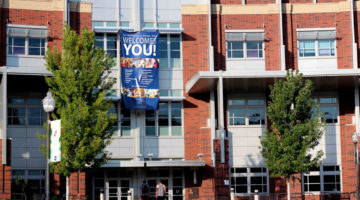
Photo courtesy of Nevada seismological laboratory
A map created by the Nevada Seismological Laboratory shows various areas of seismic activity in northern Nevada as of Monday, Aug. 24. The different colors indicate an earthquake’s age — red areas are less than 12 hours old, yellow less than one day, green less than two days, blue less than one week and white less than two weeks.
By Marcus Lavergne
The ground rumbles, rolls and rises below our feet. Research supplied by seismologists at the University of Nevada, Reno, informs us that there could be a fault line or even multiple fault lines beneath northern Nevadan homes and businesses. In the third most seismically-active state in the U.S. these faults can go into motion at unpredictable times, and the outcomes can range from unnoticeable to catastrophic.
Experts at the Nevada Seismology Laboratory, located in UNR’s Paul Laxalt Mineral Engineering building, are using their knowledge and skills to monitor seismicity, detect and outline fault lines all over the state, and study the motions or “waves” that earthquakes emit. However, this is only a small piece of the puzzle when it comes to gaining an understanding of erratic, seismic phenomena according to Ph.D student and researcher Christine Ruhl.
Ruhl has dedicated much of her time to grasping the physics of earthquakes by studying swarms, or areas packed with seismic activity. “Sheldon” is the name of a swarm that lies in Nevada’s northern Sheldon-Antelope region. It has seen over 100 magnitude 3 quakes and more than 20 measuring in at magnitude 4 all in the past year. According to Ruhl’s colleague Dr. Annie Kell, whose research involves imaging, detecting and mapping faults, these are surprising numbers considering the time the swarm has been active and how many earthquakes have been detected in the area.
“There’s so much we don’t know about earthquakes,” Ruhl said. “We’ve only been instrumentally recording earthquakes for the last 115 years. The information and the science is young, and we have a lot to learn and a lot further to go.”
Ruhl likened the “young science” of seismology to driving without a road map, but has devoted her time to studying the physics of the ruptures, how big they are and how they’re interacting.
“I see it in baby steps,” Ruhl said. “My goal is to maintain studying that kind of thing. For seismology as a whole I think people want to be safe and they want to understand [earthquakes], but they have to realize [that] the scope of the problem is huge. Contributing to this kind of research is getting at that problem. ”
Both Kell and Ruhl agree that predicting earthquakes with 100 percent accuracy may be a lofty goal, but their efforts along with the efforts of seismologists in other states, are far from fruitless. The researchers are continuously improving emergency systems that can warn the public about earthquakes before damage is done.
In order to detect the moment that seismic waves become dangerous, seismologists have separated them into two categories: less intense, quick p-waves and slow, powerful s-waves.
“Let’s say we’re talking about a fire station,” Kell said. “If there are sensors and that small, quick p-wave is detected above a certain size threshold, they just enact their emergency plan. Maybe they open the garage bay doors before the damaging s-waves get there so they can get their fire engines out. With the transit system in the Bay Area, they [would] just stop the trains.”
This lightspeed interaction between data and transmitters along with the research of seismologists like Kell and Ruth are ends to a mean in regards to improving the warning system.
Their investigations have yielded images from submarine and subterranean scans, improved fault-mapping techniques and a constantly increasing understanding of fault networks and seismic movement.
“You can’t really predict when the next [earthquake] is going to be,” Kell said. “But what we do work towards is called Earthquake Early Warning. That’s kind of the future of earthquake prediction: having a few seconds notice before the strong shaking arrives.”
She even reveals that a newer, more intricate alert system is in the works within the seismology community.
“It’s going to be amazing,” Kell said. “It’s a lot more robust and kind of complicated, and it would be something like the emergency alerts you get to your phone.”
Kell feels that even if the system only warns people a few seconds before the shaking begins, it could make a world of difference.
“People always ask me, what’s a three-second warning going to do for you?” Kell said. “In three seconds I can get under the table, and prepare for the shaking. Even a three second warning will be really significant in helping people to prepare and get into a safer situation.”
Continued research and technological advancements in the seismology lab could be imperative in preventing severe injury and even death when powerful earthquakes strike northern Nevada.
Marcus Lavergne can be reached at mlavergne@sagebrush.unr.edu and on Twitter @mlavergne21.











